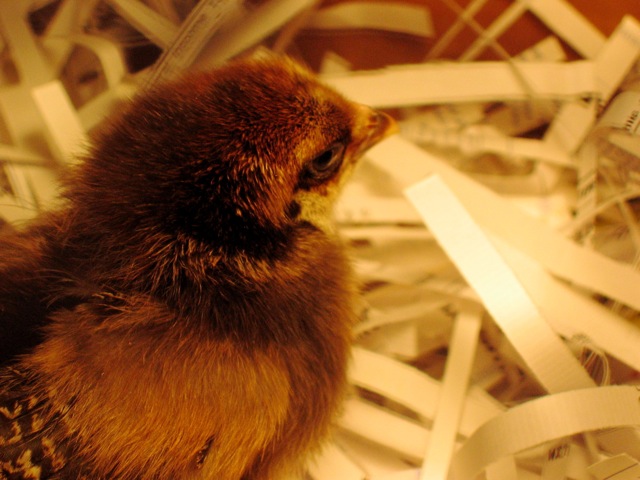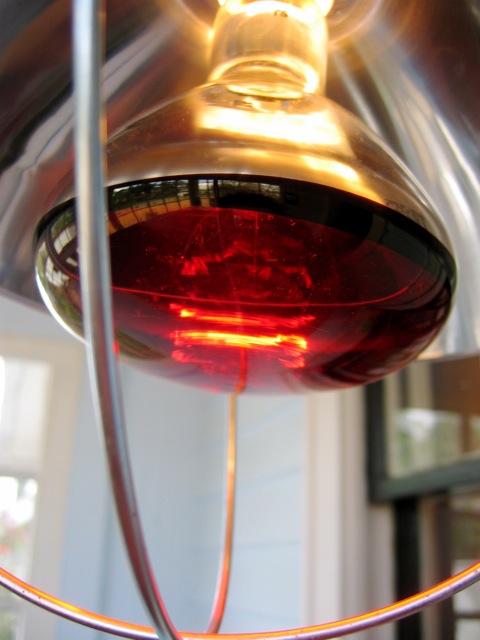
blukote, l
(article, Caroline Cummins)
[%pageBreakSettings nobreak=true][%adInjectionSettings noInject=true] As most poultry books and fowl lovers will tell you, you can keep chickens for all sorts of reasons. Third on the list is usually "fun," since chickens make social, goofy pets. Second on the list is typically "your garden," because chickens will both eat your annoying weeds and bugs and provide you with plenty of fresh, compostable manure. Tops on the list, of course, is eggs. Raising city chickens a few at a time for meat costs money, effort, and time, and doesn't produce much meat in the end. But raising a few hens as pets, gardeners, and egg providers is a nice trifecta of chicken-keeping. The eggs are the freshest possible, and since your birds presumably spend at least part of their lives outdoors eating green stuff, worms, and insects, the eggs are also the healthiest possible. [%image reference-image float=left width=400 credit="Photo © Culinate" caption="A sick chick in solitary confinement."] All good things. But anybody who thinks that raising chickens is on a par with, say, keeping a goldfish is plainly cuckoo. Chickens take work. They take up space and time. And they take money out of your wallet, most of it to the feed store. In seven days of chicken ownership, we made three trips to various shops and spent approximately $200 on birds, feed, and such motley gear and supplies as feeders, waterers, and heat lamps. Our time at home is filled with trips to the mudroom, where the chicks peep away in their cardboard castle. We stare into the box, watching the birds do their thing, wondering if their thing is normal or not. As urbanites whose bird exposure has mostly been a) pigeons, b) sparrows, and c) the occasional raptor glimpsed on a wilderness hike, we're not exactly avian experts. Fowl books and storekeepers will say things like, "Keep your chicks in a box under a light bulb. If the birds are too cold, they'll huddle under the light; if they're too hot, they'll avoid the light." Logical, right? Except that our six birds do things like pile up in a corner, away from the light, and go to sleep. Does that mean they're cold? Hot? Or just having a slumber party? [%image blukote float=right width=250 credit="Photo © Culinate" caption="Topical poultry medicine."] If we hadn't been watching the box on the evening of day 5, we might not have noticed one of the Araucana chicks having obvious gastric distress — or the other chicks suddenly ganging up on it, pecking away with casual regularity until they drew blood. Had these cute little fluffies suddenly turned into wolves, culling the diseased from the herd? We didn't know. What we did know was that one bird was sick, and needed to be segregated. So we built a second cardboard box and put Sicko in it; separated from his buddies, he promptly threw a cheeping fit, squawking loudly through the night and flinging himself against the wire ceiling of his solitary cell. By Friday, this thumping routine — reminiscent of Steve McQueen in "The Great Escape" — had given him a bloody beak in addition to his earlier wounds. Hooray. Flipping through books and webpages in our efforts to solve our sick-chick problem, we decided that we needed to fool the chicks into not seeing red anymore. First, we bought a brooder light — a serious piece of lampware, with a 250-watt red bulb — that would give everything in the chick box that sexy glow of carmine. Second, we bought a bottle of Blu Kote, a topical medicine dyed a deep indigo, that we could use to treat Stevie and mask his ailments from his fellow fowl. Third, we put Stevie back in the big cage with the wolves — and watched. He walked around. The other birds walked around. They checked each other out. And then they stuck their beaks — dyed purple from poking against Stevie — into a corner together, and went to sleep. Whew.

blukote, l

reference-image, l

redlight, l